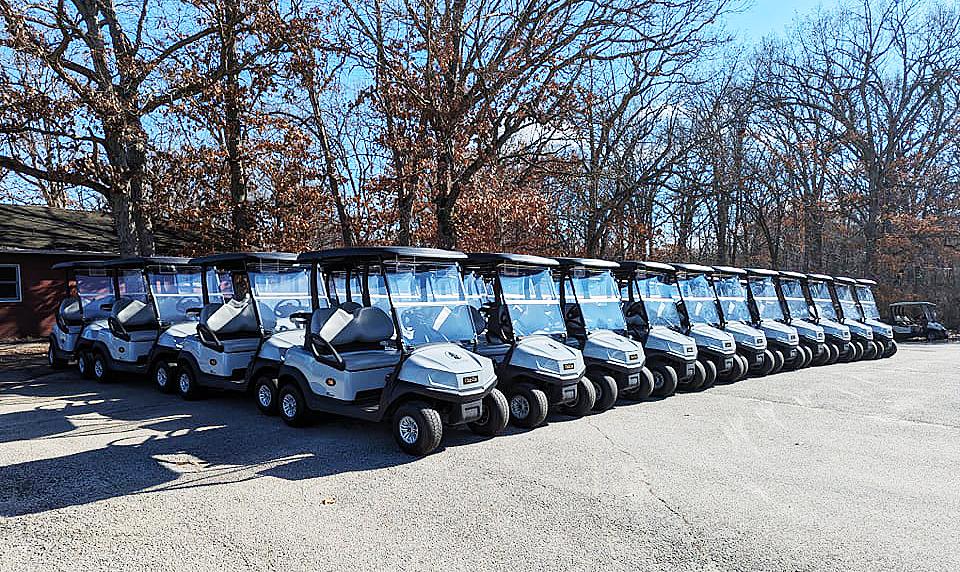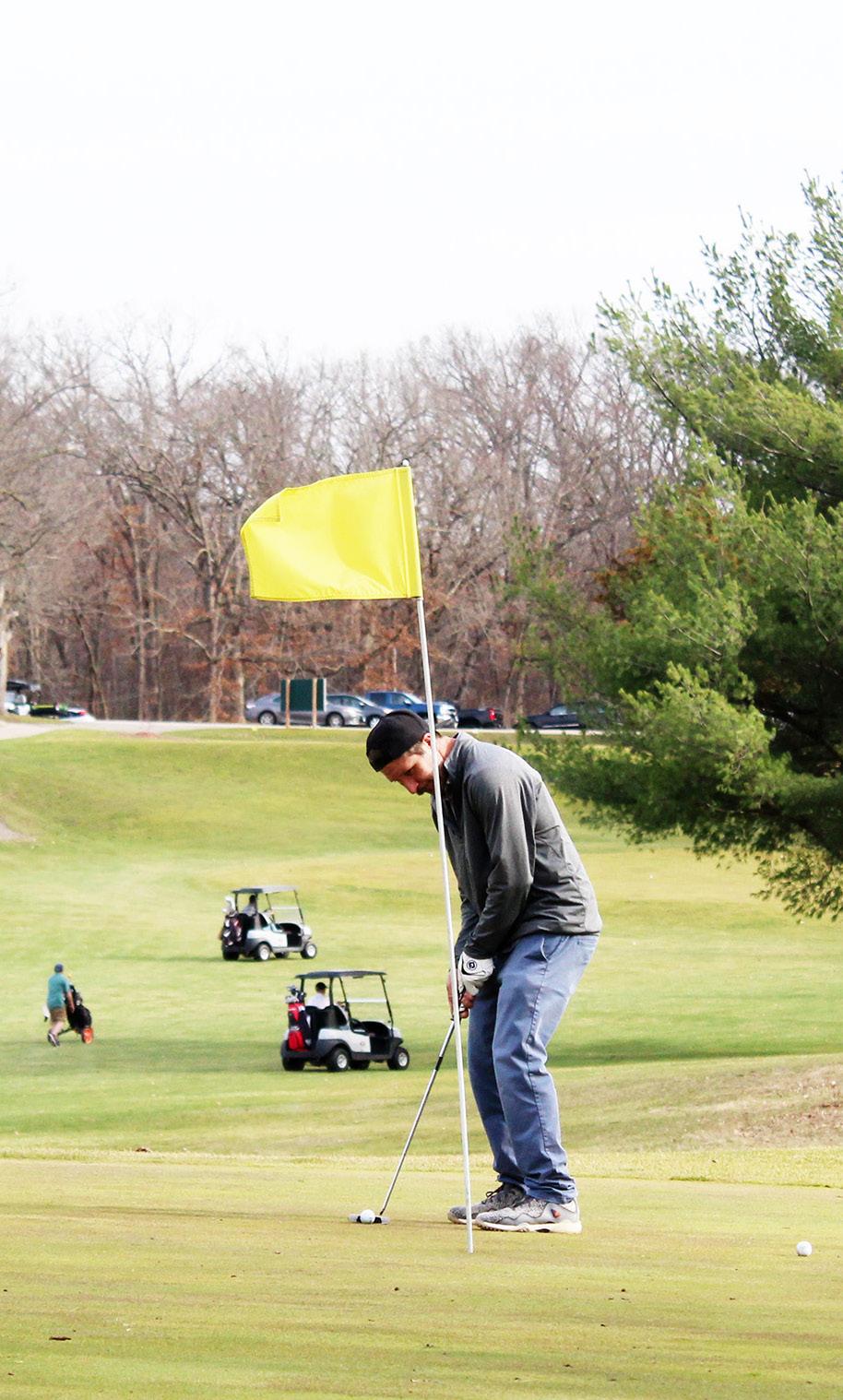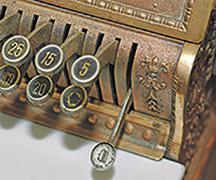








A longtime local golf course has a new owner, and he’s inviting people to fall in love with it the same way he did 4
A pair of artists have a few points to make — exclamation points, and they’re at the end of some simple words that they hope will have a profound effect on people ... I am amazing! I am an artist! I am creative!.

We all think about finding our place in life ... but what about in death? A business in rural Oregon can help, delivering the departed into the embrace of Mother Nature’s family.





















ou are amazing.
You are creative.
You are an artist.
students to believe about themselves — and these days, their message is finding a growing number of true believers.


artist inside themselves. They host workshops at libraries, park districts and businesses, keeping people engaged and entertained with their high-energy presentations.
Those words of encouragement are like the gospel according to Jerry Moffitt and Chet Roush — a motivating mantra that the dynamic duo behind Do Art Productions preaches to people in their workshops. It’s what they believe about their students, and it’s what they want their
Even if you don’t think you have a creative side, Moffitt and Roush want to show you that there’s more than one side to your story, sometimes you just need help telling it. Art, writing, acting — if there’s a talent to tap into, the former college roommates turned friends want to help you find it, and they’re doing it by hosting workshops throughout northern Illinois and beyond where people can discover a spark of creativity in themselves or polish the talents they already have — either way, it’s their students’ time to shine.
DO ART cont’d to page 6
DO
Schools, libraries, park districts, they’ll take Do Art’s message wherever there’s an audience willing to listen to what they have to say, and the first thing they say is “Repeat after me! I am amazing! I am creative! I am an artist!” — a chant that kicks off each workshop, words that they hope will be the building blocks that will build up students’ confidence.

The spirited chant is just one of the ways Moffitt, 33, of Rochelle, and Roush, 34, of Elgin, mix high energy with flashes of fun and collaborative creativity during their presentations.
“Being able to say something self-affirmative like that, especially right at the beginning when they’re starting to get to know us, it gives us a chance to kind of connect them with some energy,” Moffitt said. “At the same time, they are saying they are an artist, and they are creative.”

DO ART cont’d to page


Draw me!
Jerry
Above are some drawings students have created during Do Art’s workshops, some based on Moffitt and Roush themselves.











































The two are open to whatever it takes to get students to be creative — except being boring. They don’t want their workshops to be all work and no play. Energy and enthusiasm are their go-to techniques for relating to students, especially kids, on their own level.
“We maintain a heavy emphasis on audience participation,” Roush said. “It’s not us necessarily having an end goal in mind, it’s that we want to have the wacky, crazy energy from the audience, whether it’s kids, teens or adults, having their ideas and bringing their ideas to life.”
Workshops are offered in comic book design, painting, poetry, acting and drum making. They often use props as part of their instruction, such as riding a unicycle, playing the guitar and juggling.
The comic book workshops encompass design, plot, self-expression and character development using ideas that spring from students’ imagination. The painting workshops do much of the same, but without the comic format, using brushes dipped in bright pastels of blues, pinks, purples, yellows and greens to coax creativity from students.
DO ART cont’d to page 8




Stumped for something to draw? Don’t be: Inspiration can be found at the heads of the class. One workshop activity students have enjoyed has either Moffitt or Roush, or both, striking a funny pose and students draw them as an animal of their choice. Sometimes the students have even taught the pair a new animal in the process. Ever heard of a babirusa (a sort of deer-pig from Indonesia)? Or an axolotl (a babyfaced Mexican salamander)? Moffitt and Roush hadn’t, that is, until they turned up in their students’ work.
“You’re able to put that cartoon format over us,” Moffitt said. “We all love drawing animals, but whether it’s a dynamic pose like a ballerina babirusa, or a meditating axolotl, or a monkey on a unicycle, we bring a lot of that with the animals and the colorful energy. We like to stick with the light blues and pinks, which just kind of brings what we’re trying to blend in enthusiastically with.”


In the poetry workshops, students learn about different types of rhyme and rhythms, including haikus. Not only do students get to write and recite their own poems, they get to click with their fellow students, adding a line to a group poem written on a vintage typewriter.
Sometimes what students learn in one workshop can help them in another. In the acting workshop, students become familiar with physical expressions and emotions, and then perform a part they’ve written, something that the poetry workshop helps them do.
“One of the things that we’ve found with doing our poetry workshops is the act of using your voice, physically saying something and opening up your diaphragm,” Roush said. “It takes some of the edge
off of some of the shyness for some of the more introverted kids, and brings them out of their shell a little bit.”
Percussion and paint come together in the drum-making workshop, where students make drums out of recycled materials and then add some character to their exteriors with their own paintings and decorations, followed by jam sessions.
Moffitt and Roush, who met as college roommates at Loyola University in Chicago about 10 years ago, developed a friendship through their love of the fine arts, and they started their workshop adventures in 2022. Their creations attracted the attention of friends, and eventually trickled over to librarians and park district program directors near their hometowns who sought their talents to share with others at workshops.
It only took a few workshops for them to see they had something good going, and their schedules have been full with stops at workshops throughout northern Illinois and beyond, some that they conduct together, and others separately.
DO ART cont’d from page 10
“After we did our first ten, we saw that there was a niche of people who wanted these creative programs and this type of energy,” Moffitt said. “We saw that we had this charismatic energy that we bring to art that sometimes I don’t necessarily see in other programs. There are some paint nights where they’ll explain how you do the art and the different layers, in a Bob Ross, low-budget way. They’re doing their best to still get the art out there, but we saw with us that we’re able to bring a mix-andmatch art with a certain energy that kids can respond to.”
Kids aren’t the only ones responding. This year already, Do Art has attracted the attention of libraries and schools outside of Illinois: They recently demonstrated for an assembly of 400 students at a school in North Dakota, and have workshops scheduled later this year in Iowa, Wisconsin and Virginia.
While Moffitt and Roush enjoy spreading their word to a wider audience, they haven’t forgotten where it all started, and continue to focus on bringing their message to a local audience. Some of Do Art’s upcoming events in or close to Ogle County include comic book workshops from 11 a.m. to 1 p.m. May 11 at the Winifred Knox Public Library in Franklin Grove, and from 10 a.m. to noon June 14 at the Belvidere Park District; a three-day acting workshop from 10 to 11 a.m. July 10, 17 and 24 at the Nash Recreation Center in Oregon; and a three-day comic book workshop from 10 a.m. to noon July 30 through Aug. 1 at Jubilee Artisans in DeKalb. Go to doartproductions.org for a full schedule of events.
The more workshops they add to their busy schedule, the more hidden talents they’re finding.
“Often times if there’s a prompt, even if it’s an invitation, with kids or adults, that’s what sparks their own idea that we would never have thought of,” Roush said. “Just having that invitation will bring out that creative energy in people.”
DO ART cont’d to page 10













DO ART cont’d from page 9
Sometimes it takes a little gentle coaxing to ignite that spark, but when the light finally comes on, there’s nothing quite like it.
“I feel like when they’re able to feed off of our confidence of being able to perform for them, they’re able to take that home in the creative process,” Moffitt said. “It’s very fun and unique to see it all come out.”
It’s not unusual to come across students — especially younger ones — who are nervous about putting themselves out there: coaxing a creation from the corners of their mind and sharing it with others. They might withdraw, but with a little encouragement from Moffitt and Roush they’ll see that the workshops are a safe space where inspiration and ideas have

found a place to call home.
“We try to spark that creativity, because a lot of times people think that they are not good at art, or that they’re bad and don’t want to be embarrassed,” Moffitt said. “By now we’ve been able to have a gift of getting it out of them. When you’re able to give them a prompt, and give them the energy with that prompt, it’s easier for them to feel looser when they’re drawing something.”







Oftentimes, students will discover that to find their creativity, all they have to do is stick to it.
“Even if it’s a stick figure, you can draw a stick figure with a goatee on or with a hat,” Moffitt said. “With the stick figures, everyone can draw an ‘O,’ everybody can draw a ‘T,’ so I know they can draw a stick figure and get that far. Then you can give the stick figure an eye patch, or a hat, and so we’re just trying to pull that creativity out of people even if they may feel hesitant with it.”
Ultimately, whatever art a person creates, it’s an expression of one’s self: what they’re thinking, what they’re feeling, what they want so say. Moffitt and Roush’s job is to help them find the words to say it.
“You’ll probably draw a different stick figure in the morning than you do at night; it’s just because the moment takes on a different form of expression,” Moffitt said. “You can ask a hundred or a thousand people to draw you, and not one of them will be the same. Even if it’s just scribbles, it all shows a little bit of their personality, even when they’re trying not to.” n
Cody Cutter can be reached at 815-632-2532 or ccutter@shawmedia.com.






long as Kay Guzzardo is buying and selling interesting things she sees, class is still in session at Holcomb’s old school — and these days, it’s full of history lessons.
In 1969, Guzzardo turned the then recently closed school into an antique store, and 55 years later, Schoolhouse Antiques is still rekindling memories, not only with its antiques, but with the business itself.
“The town revolved around the school,” Guzzardo said. “We’ve been here all these years, and everybody calls it the school still.”
From the everyday to the eclectic, the shop is full of merchandise that’s a stroll down memory lane — furniture, chairs, tools, jewelry, quilts, housewares, dolls, trains, frames, doors, windows, artwork, lighting, toys, glassware, dishes, books and a whole lot more — filling tables and shelves in the old school’s classrooms, hallways, gymnasium and performance stage, areas students once roamed, learning all sorts of interesting things about life while growing up in a small, rural area.


SCHOOLHOUSE cont’d to page 14
It's been 70 years since Holcomb’s Kay Guzzardo was a student in a classroom where she now sells antiques. Guzzardo graduated from eighth grade at the town’s school in 1954, and has owned Schoolhouse Antiques in the building since 1969.


Center court at the former Holcomb school gym (right) has looked the same since the building opened for students in 1933. Today, the gym is one of the showroom floors for Schoolhouse Antiques. Tell-tale signs of the shop’s former tenant can still be found throughout, like the chalkboards lining the walls (above).
Guzzardo was one of those kids, attending school there until her eighth-grade graduation in 1954. She can still point to where her desks were in either of the school’s two classrooms.
“We hung the flag. We said a prayer. We had music. We had really good teachers,” she said. “I loved school.”
Another lifelong love of Guzzardo’s is appreciating pieces of the past — the history and the mystery of merchandise from days gone by, learning about them, figuring out what they were used for, and helping them find a new home with her customers.

Her mother, Floy Musser, ran a gas station in nearby Kings when Kay was a young adult, and both mother and daughter would meet the occasional customer who would sell all sorts of antiques and other interesting items from the backs of their cars and trucks.
“My mother ran a gas station years ago, and when people would get gas, they would sell their wares out of the trunks of their cars,” Guzzardo said. “My mother and I would buy out of their trunks and put them in our gas station and sell them. She was a hard worker, and she could make money.”
SCHOOLHOUSE cont’d to page 15

















The apple hasn’t fallen far from the tree — or the teacher’s school desk. Like her mother, Guzzardo developed a keen eye for turning collectibles into cash, and when the school she loved closed its doors in 1969, she found a way to open them back up and keep the building part of the community, following in her mother’s footsteps, and her own: the ones she walked as a student there.
She and her husband, Sam, bought the vintage-1933 building at an auction that year and Kay moved her merchandise into the school where she’s selling it ever since. It turned out to be the biggest buy that she Sam ever made. After buying it, they spent a couple of years building an addition to it where they would live.

Countless items, both ornate and simple, have come and gone from the school-turnedstore in the past 55 years — and some of them in the shop today aren’t even as old as the business itself. Though traditionally, something is considered an antique when it’s 80 years or older, but Guzzardo has seen that definition change over the years.
“It used to be that an antique was supposed to be 100 years old,” Guzzardo said. “Those days are gone. If you’re a 20-year-old, your grandparents would maybe be 65 or 70. So whatever they had, to those kids it’s collectible.”
SCHOOLHOUSE cont’d to page 17


Looking for holiday decor? Every day is Christmas at Schoolhouse Antiques. These days, vintage holiday decor is becoming more popular than decorations made in recent years, owner Kay Guzzardo said.


Do you like antiques?
Then this schoolhouse rocks ...
If it’s got history, it’s got a home at Schoolhouse Antiques — household goods, vintage kitchen items, old radios, furniture and more.










She’s shopped at many pop-up and flea markets throughout the Midwest on quests to find interesting and unique things to stock her store. Farm auctions were popular go-to destinations for her until most of them moved from in-person to online set-ups. She’s also had people bring their items to her to see if there’s something that piques her interest.
She continues to make the local rounds at popup markets when she can, these days with her children helping her out, after Sam passed away in 2016.
Even after all these years, she still finds it enjoyable.
“It’s never been work to me, ever,” Guzzardo said. “I was doing four markets a month. My daughter went with me one day and said, ‘Mom, how do you do it?’ I said, ‘It’s not work. It’s never been work. It’s still not work.’ I don’t care how long I’ve been selling, I still find something new. It’s just fun, that’s all I can say. I’m not a big collector, I like to buy, and I like to sell, equally.”
home. This has been wonderful to be open the way I have.”
Guzzardo also avoids selling her items on eBay, preferring a more personable approach to her transactions. “It’s not fun,” she said. “I like people. I think it’s all about people, and it’s always been about people.” That doesn’t mean she shuns modern tech altogether. She uses Facebook and its Marketplace communities to attract shoppers from well beyond Ogle County.


As for the store, it’s open by appointment, or whenever Guzzardo posts a block of hours — typically during weekends — on its Facebook page. In recent years, the appointment-based availability has become beneficial to Guzzardo, who will turn 84 this year. She doesn’t have to be tied down to set hours and can keep the store going on her own terms.
When you come, bring paper, not plastic; the business is check or cash only.
“People have asked me why I don’t have regular hours,” Guzzardo said. “I’ll tell them that I’m old, I’m independent, and I don’t want to. That’s the truth. I don’t want to be tied down. But, I will open if you knock on my door and I’m
“We didn’t have Marketplace a long time ago,” Guzzardo said. “People read that every day, and they’re antiquers. I’ve had people come out of [Chicago] and people from Madison. People like to take drives today, they want to take a drive and buy antiques. Marketplace has been so good. People love to find a bargain, and love to find a new place.”
Google has been helpful, too. When it comes to the more unusual items she finds, an online search can solve many a-mystery.
“You’re always learning,” Guzzardo said. “You find something and go, ‘What is that?’ Then you’ll talk with people. Now, you can get on Google. That’s a little easier than what it used to be.”
The evolution of the antiquing industry and constant curiousness keeps Guzzardo going after all these years. She doesn’t plan on quitting until her body tells her to.
“With people today, you never know who’s going to come through the door and what they collect,” she said. “My customers have all been wonderful. They really, really have. I may have some things here that may not be worth a lot, but people love that stuff.” n
Cody Cutter can be reached at 815-632-2532 or ccutter@shawmedia.com.


ver face one of those cravings conundrums: You’re hungry for something from your favorite restaurant in town, but just can’t make it over there to grab a bite to eat?
Andrew Carlson has an answer: He’ll grab it for you.
Carlson is the man in the driver’s seat of ChowDown Otown, an Oregon business that’ll pick up a bite to eat for customers and drop it off at their door.
Like any good business idea, it started with a niche that needed filled and a person willing to fill it — and it had a little help from an unlikely source: a pandemic.
An Otown resident himself, Carlson had been toying with the idea of a food delivery business for about 7 years, but when the coronavirus pandemic hit in 2020 and he saw the struggle restaurants in his hometown faced when shelter-in-place orders were in effect, he decided to do something to help: Get behind the wheel.
Maybe you’re at work and can’t take a break. You’re at home and can’t make it out to a restaurant. Or maybe you’re at the park and feel like a picnic? Carlson’s the man to call — and even now, with the pandemic in the rear view mirror, people are still calling. Carlson continues to keep busy bouncing around Oregon like a pinball making deliveries left and right, and he enjoys connecting customers to a world of flavors from his hometown’s cuisine — American, Mexican, Chinese — sweet treats, or even just something to sip on.


CHOW cont’d from page 19
“There are a lot of people who may not even know that we had a certain restaurant in Oregon,” Carlson said. “That’s probably my favorite part about it, helping put a spotlight on places in town and showing off what we have because we have some really interesting stuff, right in their own back yard.”
Carlson’s will deliver anywhere within 15-minute drive from downtown Oregon (an area that also includes Chana, Daysville, Mount Morris and Paynes Point): homes, businesses, factories, parks, campsites.
Carlson has full-time arrangements with around 15 places in Oregon to deliver their food, including Bela’s Cafe, Blackhawk Steak Pit, Breakers Saloon, China King, Dairy Queen, Hazel’s Cafe, Hector’s Cocina, Jay’s Drive In, Maxson’s, Ogle County Brewery, Sledgehammer’s, Spring Valley Family Restaurant, Subway and The Village Bakery. He also assists other places in town on occasion, such as Father and Son Pizza and The Noble Cakery, whenever needed.
Customers call or text Carlson at 815-979-1037 between 11 a.m. and 8 p.m. Monday through Friday to place their order. Carlson will then arrange the order with the restaurant and contact the customer with their order information, cost (including delivery fee) and estimated arrival time.
CHOW cont’d to page 22

SUPPORTING THE FARMERS OF TOMORROW


The future of agriculture depends on our hard work today. That’s why we’re proud to support the National FFA Organization and help inspire the next generation of agriculture dreams.













CHOW cont’d from page 21
Carlson sometimes has to juggle multiple orders and deliveries at once, and figuring out the delivery logistics has been both interesting and challenging, but it’s gotten easier with experience.
“I’ve done everything from delivering a single beverage to someone to full-on catering,” Carlson said. “During the afternoons, I’ll get some of the local businesses — factories and the bigger employers — get their corporate lunches coordinated through me and I can get it out to them. It all works out pretty good.”
The pandemic put Carlson’s idea of a delivery service into motion sooner than he had anticipated. He had discussed the idea with a few restaurateurs in town before that, but when the pandemic put the food service industry in peril, they reconnected with Carlson to have him help them out. That signaled the start of ChowDown OTown, and once word got around town about what he was doing, more restaurants became interested in his services.
CHOW cont’d to page 23




It didn’t take long for ChowDown OTown to get up to speed.
“I wasn’t ready for the response,” Carlson said. “I had the idea in my head, and I reached out to a few restaurants to let them know what I was thinking about, pooling together to have one delivery service. The idea was there, but then Covid happened. The shutdowns happened, and all of a sudden they were calling me and saying, ‘Can we do this next week?’ ‘Uhh ... sure.’ We just kind of threw it together. Everything went real quick, and I learned on the fly.”
The pandemic helped give rise to delivery services nationwide such as DoorDash, GrubHub and UberEats, but with ChowDown OTown, there’s a more local connection to cuisine. Carlson is a one-man operation, so customers will see the same person delivering each order.
In addition, Carlson also helps out the businesses he works with in promoting them on ChowDown OTown’s Facebook page, by sharing lunch or dinner specials they may post on their page.
“I always tell people that we’re a more rural version of UberEats, I can work with people a lot better than with an app,” Carlson said. “I try to represent, as ChowDown, I feel like I’m representing each restaurant. I’m not just going to throw it on your porch. I try to treat each restaurant’s food with the respect that they want it to be presented.”
Carlson grew up in Oregon and returned to town in 2016 after about 20 years away. Operating his delivery business has helped him develop a greater appreciation for the community, he said. “I love everything about Oregon, I always have. It’s always been home to me. It’s good to get out to see people and help our local business feed the community.”
“Everybody that I deliver for, they’re used to me calling and they know the whole routine,” Carlson said. “Right now, it’s pretty good.” n
Cody Cutter can be reached at 815-632-2532 or ccutter@shawmedia.com.

ChowDown OTown delivers food from select restaurants in Oregon to residences, businesses, lodging quarters and campsites within a 15-minute drive from town. Call 815-979-1037 between 11 a.m. and 8 p.m. Monday through Friday to place an order. Find it on Facebook for more information, and to view specials from the aforementioned list of restaurants.




















One of the slogans that Lost Nation Golf Course has used on its scorecards to attract golfers over the years was to invite them to “get lost in the game.”
But as it faced an uncertain future at the end of last year, something else could have been lost: the course itself, and fans of Lost Nation didn’t want to see that happen.
Dan Whalen was one of those people, and that’s why he decided to do something about it.
He bought the course.
Whalen didn’t want to see Lost Nation become another fallen domino in the golf course industry, so after its longtime owners decided to sell last year, Whalen stepped up to keep the course along Ogle County’s southern edge and near the Rock River open. He assumed ownership Feb. 2 and he’s set his sights on making the course even better than before.
One of the first changes that he’s made: being a hands-on owner. Whalen tries to make it to the course every day to help out where needed, whether it’s in the pro shop, clubhouse or in the maintenance yard — and if there’s an issue, golfers won’t have to wait for someone from out of town to show up: He lives just a few drive shots away.
LOST NATION cont’d to page 26
Lost Nation Golf Course’s new owner is no stranger to the longtime local golf course.
Dan Whalen took over at the course on Feb. 2, but before that he’d been a regular there. Once he started golfing there, it didn’t take long to get hooked: “I fell in love with the course,” he said.
CODY CUTTER/CCUTTER@ SHAWMEDIA.COM

Whalen, who grew up in Oregon, has golfed regularly at Lost Nation for a few years, and has come to love its layout, beauty and camaraderie among fellow golfers.
“I love coming over, and I fell in love with the course,” Whalen said. “I like the layout. I like that it’s challenging, but still on the easier side and you won’t lose a ton of golf balls. The people out here have been awesome, and I’ve made a lot of new friends over the past four years. That was one of the reasons why I decided to move forward with pursuing the purchase.”
The 18-hole, par 71 course (par 72 for the shorter tees) is tucked away from busy highways and has several natural features not seen at other courses, due to its location near woodlands and the river. The nearly-170-acre course drains well after rain and snow as it sits on sand-based soil, similar to the nearby Nachusa Grasslands. Unlike courses on regular soil, the quick drainage allows the course to be ready for play earlier in the year, and it takes less time to rebound from the rain.
Eddie Roller lines up a putt on No. 8 at Lost Nation Golf Course during a round with friends in mid-March. LOST

Two skaters will get in for the price of one, any regular session. Come in, we’re open!
Friday 7-10PM
Saturday 1-4PM & 7-11PM
Sunday 1-4PM (October-June) 815-946-9988






815.973.2432
Open Tuesdays, Thursdays & Saturdays 9am-5pm

Upcoming


As a result of its favorable terrain, Lost Nation welcomed its first golfers on Feb. 18, in 50-degree weather, and improvements to the course and facilities are being made as the season progresses. The removal of dead trees and pesky crabgrass has been a top priority for early spring, and that will follow with the planting of wildflowers and installation of birdhouses.
The course already attracts all sorts of animals due to its naturefriendly surroundings.
“There wasn’t much invested over the years, so bringing everything back up to where it should be is a high priority,” Whalen said. “Its enhancing the beauty that you see when you’re here, with the hills and the nature, and with the deer that come over from Lost Lake, as well as turkeys, turkey vultures and bald eagles.”
One of the ways Whalen is trying to attract more golfers is by making a slight change to Lost Nation’s name.
When it opened in 1964, it was called Lost Nation Country Club, and later became Lost Nation Golf Club. Today, Whalen has decided that the only clubs he wants people to find are on the course, not its signs, which is why he swapped the “Club” in its name for “Course.”
































































































































